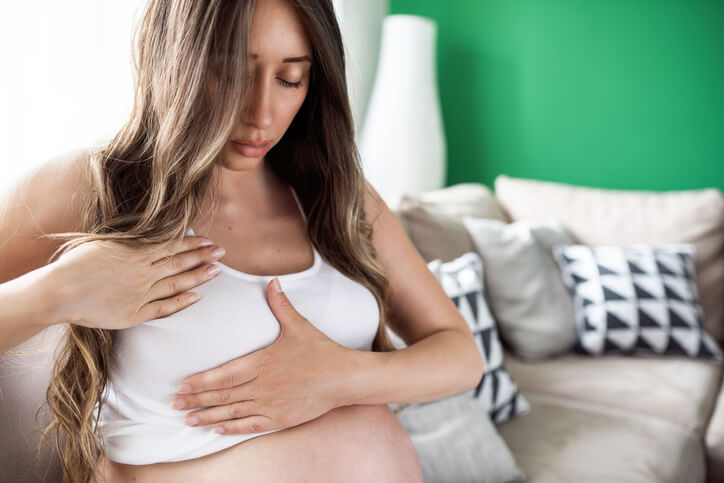Tenderness and soreness of the breasts are extremely common during pregnancy.
For many women, it is one of the telltale early signs of pregnancy.
However, what many women don’t know is that breast pain often changes throughout the stages of pregnancy as a woman’s body prepares for childbirth and breastfeeding.
What Causes Sore Breasts in Early Pregnancy?
Sore breasts are one of the most well known symptoms of pregnancy.
For many, soreness and fullness of the breasts are also the first signs, potentially occurring even before a missed period.
Sore breasts in early pregnancy are caused by the rapid increase in the production of pregnancy hormones, including progesterone, estrogen, and prolactin, following conception.
The body releases more of these hormones to prepare for lactation and breastfeeding.
The increase in pregnancy hormones creates more blood flow to the breasts.
The hormones direct the milk ducts to start growing, and the breasts change to hold in extra fluid, fat, and tissue.
The nipples also tend to become larger and darker to help the baby see them and latch on during breastfeeding.
These hormonal changes mean that many women see their breast size increase by as much as a whole cup size or more during pregnancy and breastfeeding, which causes additional soreness and sensitivity.
What Part of the Breast Hurts in Early Pregnancy?
The breast tissue that most often becomes sore and tender is actually the tissue that makes up the nipples.
The increased blood flow and hormones can cause the nipples to become hypersensitive, and some women may experience a feeling of pins and needles, or tingling, in the nipples and areolas during the first pregnancy stages as these areas grow.
Something as normal as putting on a bra or drying off after a shower can be too painful to bear.
However, this early-pregnancy sensitivity typically decreases as the pregnancy progresses.
In a few weeks, pregnant women typically start feeling increased heaviness and fullness in their breasts as the soreness lessens.
How Does Breast Pain Change Throughout Pregnancy?
While the earliest signs of breast pain during pregnancy are most commonly felt in the nipples, breast pain does change throughout pregnancy.
Each trimester is likely to cause different symptoms as a woman’s body prepares for childbirth and breastfeeding.
First Trimester
As noted, the first signs of breast pain during pregnancy occur in the first trimester, or weeks 1 through 12 of pregnancy.
Breasts are likely to feel tender and tingly with significant sensitivity in the nipples.
Many women experience an increase in breast fullness during this time and may notice that their nipples protrude more than usual.
Other common symptoms of pregnancy during the first trimester can include exhaustion, cravings, and morning sickness.
Like breast tenderness, these symptoms typically improve as a woman moves farther along in pregnancy.
After ovulation and the break in a woman’s menstrual cycle, hormone levels continue to increase until week 10.
These levels should begin to even out after week 10.
Second Trimester
The breasts continue to increase in size during the second trimester, which is weeks 13 to 28 of pregnancy.
At this stage, many women need to purchase a larger bra size or rely on bras with more support or stronger underwire to help support the breasts.
Women also typically notice a change in the appearance of the breasts:
- Veins typically become more visible underneath the skin
- Nipples and areolas get larger and darker
- Stretch marks may appear as breasts grow bigger
Women may also begin to leak a fluid called colostrum, which is a watery, yellowish fluid that is a precursor to breast milk. However, not all women experience this.
Third Trimester
During the third trimester, which is weeks 29 through 40 of pregnancy, a woman’s body undergoes final preparations for childbirth and breastfeeding.
Sore nipples and tender breasts are likely to continue as the breasts become even larger and heavier as they fill with milk, and nipple discharge may increase.
Nipple discharge can vary in color, including white, yellow, green, brown, or even red if there is blood in the discharge.
Though it may feel uncomfortable, nipple discharge is very normal. Breast pads can help absorb the fluid discharged during this time.
How Can You Relieve Breast Pain During Pregnancy?
The typical 40-week pregnancy is a long time to endure breast pain, so it’s no surprise that many women seek relief.
There are many ways to cope with breast pain during pregnancy — here are some of the most common.
Searching pregnancy products? We have some recommendations! 🤰🤰
👶👶 TOP RECOMMENDATION: The Genate Prenatal Nutritional Test: Optimize the prenatal nutrition you share with your developing baby or newborn: LEARN MORE.
——- Additional Recommendations ——
📚 Mayo Clinic Guide to a Healthy Pregnancy, 2nd Edition: LEARN MORE.
📚 The Pregnancy Encyclopedia: All Your Questions Answered: LEARN MORE.
🧘 WorkoutLabs Prenatal Yoga & Ayurveda Cards: LEARN MORE.
*If you buy something from a link on our site, we may earn a commission. See our advertising disclosure.
Gently Ice Your Breasts
Breasts that are swollen and painful may benefit from gentle icing.
Try applying a cold compress or ice pack to the breasts to reduce blood flow and minimize pain.
The cold will help reduce nerve activity, which can improve symptoms.
When icing, ensure there is some kind of fabric barrier between the ice and the skin — putting ice or even a frozen pack directly against breast tissue can be too harsh for sensitive breast tissue, so simply wrapping cold compresses or ice packs in a layer of cotton (think towel, tshirt, etc.) can make for more soothing, gentle relief.
Use Breast Pads
Nipple sensitivity is a common problem, which is why using breast pads can help if the lining of the bra is especially irritating.
Breast pads can help by protecting nipples from irritating surfaces, and can also help mitigate leaking caused by nipple discharge, so they’ll pull double duty later in pregnancy.
Buy a More Supportive Bra
As the breasts increase in size and the nipples become more tender, a more supportive bra may be necessary.
Simple cotton bras that provide full coverage can help reduce nipple irritation, while a larger, more supportive bra can address heaviness and fullness that is causing pain.
After pregnancy, using a nursing bra can provide breast support while making it easier for a baby to breastfeed.
Sleep in a Bra
Sleeping in a bra might sound uncomfortable, but it can be helpful during pregnancy.
A good sleep bra option is a sports bra. Sport bras provide additional support and prevent nipple irritation, addressing two of the most troublesome symptoms of breast pain during pregnancy.
The Bottom Line
Breast pain during early pregnancy is very common as the nipples become more tender and sensitive.
Breast pain occurs as a woman’s body begins to produce extra pregnancy hormones, including progesterone, estrogen, and prolactin to prepare for childbirth and breastfeeding.
There are several ways to cope with sore breasts during pregnancy, including wearing a sports bra when sleeping, using breast pads, and applying cold compresses as needed.
If at any time you feel something about your pregnancy is not right, such as unbearable breast pain, immediately contact your OB-GYN, women’s health specialist, or primary healthcare provider for additional guidance.
References and Sources:
Colostrum: What Is It, Benefits & What To Expect | Cleveland Clinic
Hormones During Pregnancy | Johns Hopkins Medicine

Bridget Reed is a Tampa-based content development manager, writer, and editor at GR0; specializing in content related to varying fields including medicine, health, and small businesses. Bridget went to St. Petersburg College and majored in Management and Organizational Leadership.
Recent Publications: Body Acne 101: Prevention and Treatment, Stress Acne: Causes, Prevention, and Treatment, What are the Side Effects of Midol?

